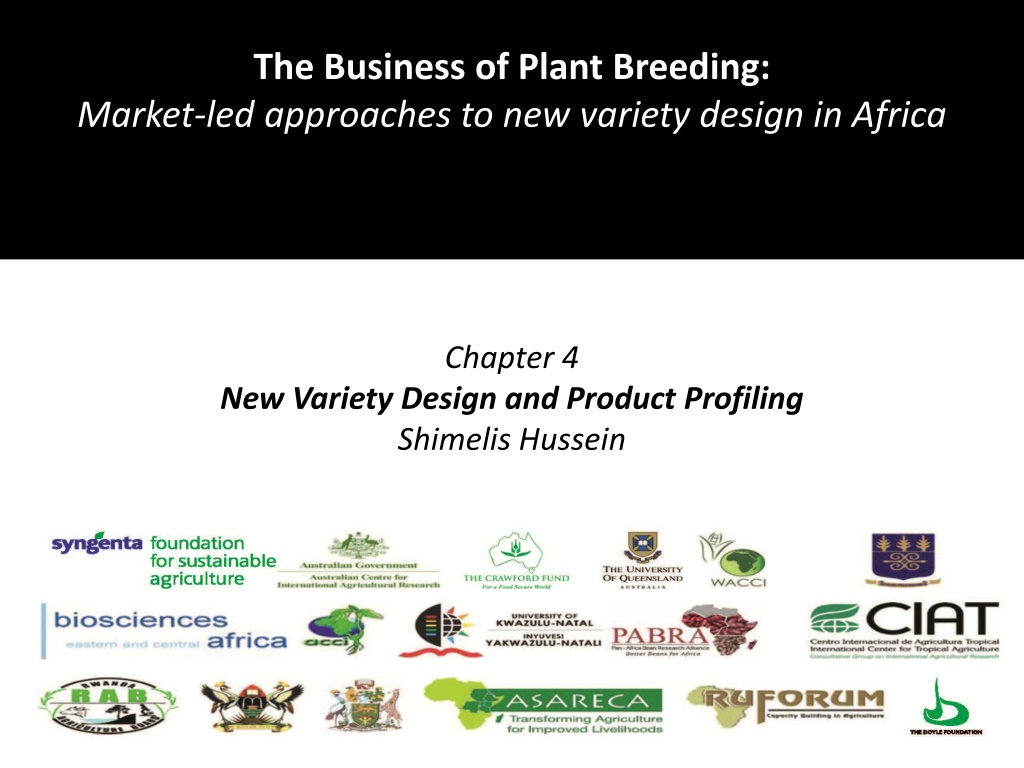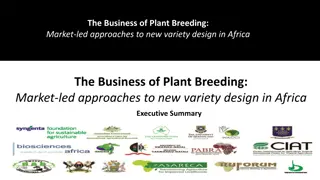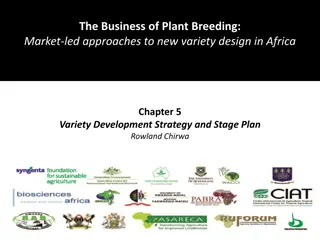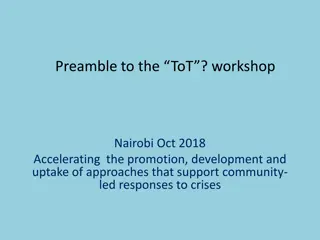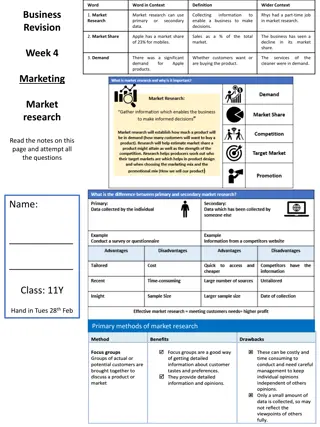Market-Led Approaches to New Variety Design in Africa
Explore Chapter 4 of "The Business of Plant Breeding" focusing on new variety design and product profiling in Africa. Understand core methods of product profiling, trait prioritization, and setting breeding objectives to meet client needs. Learn how to create new designs, set benchmarks, and make trade-off decisions using demand-led approaches. Discover the process of translating new variety designs into practical breeding programs with clear goals and objectives.
Download Presentation

Please find below an Image/Link to download the presentation.
The content on the website is provided AS IS for your information and personal use only. It may not be sold, licensed, or shared on other websites without obtaining consent from the author. Download presentation by click this link. If you encounter any issues during the download, it is possible that the publisher has removed the file from their server.
E N D
Presentation Transcript
The Business of Plant Breeding: Market-led approaches to new variety design in Africa Demand-Led Plant Breeding Training Manual Chapter 4 New Variety Design and Product Profiling Shimelis Hussein
Chapter 4 New Variety Design and Product Profiling Shimelis Hussein Africa Centre for Crop Improvement (ACCI) University of KwaZulu-Natal P/Bag X01, Scottsville 3209, Pietermaritzburg South Africa
Chapter 4 Objectives 1. To understand the core method of product profiling to: - Characterize existing varieties used by farmers; and - Identify future properties important to clients and other stakeholders along the value chain 2. To understand how to create new designs and set benchmarks to meet client needs 3. To understand how to prioritize a range of traits using demand-led approaches and make trade-off decisions 4. To understand how to translate a new variety design into a practical breeding programme with clear goals and objectives
Chapter 4 Contents 1. Introduction 2. New Variety Design and Product Profiling 3. Creating a Product Profile 4. Trait Prioritization 5. Setting External Performance Standards 6. Validating Variety Designs 7. Translating Product Profiles into Breeding Objectives 8. Conclusion
1. INTRODUCTION Opening Group Discussion How do you design your new varieties? How do you decide the performance required from your new varieties?
2. NEW VARIETY DESIGN AND PRODUCT PROFILING
New Variety Design Target clients Define who the new variety is targeted to serve i.e. what market segment(s) Value chain needs Understand clients and stakeholders along the whole targeted value chain Crop uses Define all uses of the crop as food, feed, energy, propagation seed or other purposes Variety identity and descriptors Understand every facet of the crop plant, pre and post harvest and differences between varieties
New Variety Design Variety awareness and demand - Regular contact with clients and stakeholders. Involve them in decision-making and testing of new designs to create product pull and widespread use of the variety when it is registered Product profiling - A productprofile is the name given to the technical specification of a new variety. This design specification contains a detailed set of technical attributes or traits with quantitative measures Trait prioritization Determining the relative priority of different traits in a new variety design is an important and active process in demand-led variety design
New Variety Design and Product Profiles Key messages Up-to-date qualitative and quantitative market research data on clients needs are essential to make decisions A key aspect in the design (often overlooked) is the cost and feasibility of seed multiplication To understand and create an advocacy programme with government regulators to adapt current registration requirements to include new, market-led design features that offer additional benefits to farmers and consumers
Client and Market Importance The core goal for a demand-led breeder is to create a new variety that meets a client demand by either: - Improving design features within existing varieties, - or - Providing new benefits that will increase new varietal adoption. The four main inputs required for new variety design are: Market research Variety performance Traits required Trait prioritization
Client and Market Importance A primary consideration in demand-led variety design is how to define the inherent and relative value of each trait within the product profile, by considering: Technical and scientific feasibility Trait combinations may be difficult or impossible to achieve due to fundamental physiological or genetic reasons Legal considerations and freedom to operate Access to germplasm and native traits that have intellectual property rights and are owned by others requires careful consideration Skills and resources Delivery requires the appropriate personnel, skills and resources to be available Cost The variety design must be affordable
Individual Exercise List five traits that you are breeding for and who is benefiting. Place the traits against the primary beneficiaries.
What is a Product Profile? The name given to the full range of technical attributes of a new variety with quantitative measures Also called ideotype or product specification The best product profiles always set a target benchmark for the required performance of each trait; by comparisons vs. the performance of existing varieties and/or expressed on a numeric or photographic scale Trait descriptors/dictionaries are compiled and published by the CGIAR International Research Centres and national research intuitions
Product Profile and New Variety Design A product profile is required for each prospective new variety that can be communicated to other breeders, scientists, managers and non-scientific stakeholders International crop descriptors are a prerequisite to proceed Each product characteristic required must be quantified and measurable vs. a target benchmark The product profile needs to be tested with customers before major investments in a new breeding programme
Creating a Product Profile Performance required (=, >, >=, >>) Trait Variety benchmark Trait category No Trait description 1 2 1 2 1 2 1 2 Crop yield Plant architecture Seed production Biotic stress Abiotic stress Crop handling, harvest, storage, transport Value chain clients, consumers, processors 1 2 1 2
Example of Variety Profiling (Zucchini) Arlika Alfibio Carisma Tulsa Iskander Otto 17
Product Profile Design Trait type Trait description Quantification Benchmark Performance Variety required Blossom end scar size Colour Fruit size (in cm) Fruit shape Small Otto Carisma Otto Queen = = Light green 16-18 Cylindrical > = = Fruit uniformity High Queen = Early marketable yield Marketable yield (tons/1000 m2) Good Otto > = Harvest & storage Low waste Otto = Easiness to pick (peduncle over 4 cm) High Carisma = Handling (skin) tolerance Consistency and post- harvest life Good Otto > = Good Queen =
Farmers preferences Trait performance benchmark Easiness to pick Peduncle over 4cm cv. Clarita SL5 cv. Clarita SL5 19
Retailers preferences Trait performance benchmark Peduncle shelf-life cv. Queen/Asg
Consumers preferences Trait performance benchmark Fruit size 16-18 cm Glossiness vs. Otto cv. Otto
Priority of Traits Important and challenging decision for every breeder Market evaluation for each trait has two dimensions 1. Differentiation Willingness to pay price premium Opportunity to grow market share 2. Market demand % growers/area that need this trait
Trait Prioritization Willingness to pay price premium 10 8 Opportunity to grow market share Niche opportunity Winning traits 6 Differentiation 4 Low potential Essential traits 2 0 20 80 100 60 40 Market demand % growers/area that need this trait
Trait Prioritization 10 Winning traits Niche opportunity Yield Plant architecture Biotic stress Abiotic stress Crop handling Consumer preference 8 Differentiation 6 4 Differentiation Willingness to pay price premium 2 Opportunity to grow market share Low potential Essential traits 0 20 80 100 60 40 Market demand % growers/area that need this trait
5. Setting External (Non-Market) Performance Standards for a New Variety What are the non-market standards that you have to meet in order to get a new variety released and grown?
Setting Non-Market Standards Variety registration requirements: Dialogue with key officials re registration processes and time frame; markers for varietal identification, adoption, monitoring, performance assessment; requirements for new consumer-based traits e.g. nutritional quality Advocacy: Create an advocacy programme for changes in registration to assess requirements for market-led traits Seed production and scaling: Scaling up seed multiplication and what are the associated costs? Seed production costs decide commercial viability
Considerations on External Standards of a New Variety Traits known and part of the official crop descriptors or creating a new variety with a very different phenotype Minimum requirements set by the national testing agency or national variety releasing committee Traits adhere to farmers or market or industry preferred requirements
Considerations on External Standards of a New Variety The need for historic performance data (genotype x environment, stability analysis) Field and laboratory evaluation protocols to make comparisons Government interest and urgency for the new variety Relative performance of a new variety vs the national list of recommended varieties
Variety registration, breeders' rights and control Variety registration requirements, breeders' rights and the way cultivars are commercialized differ across countries Within a country the requirements may differ for different crops A new variety has to be registered and should appear on the recommended list of cultivars The new cultivar has to be an improvement over the benchmark using a set of variety descriptions
Variety registration, breeders' rights and control Several countries (>73) are member of the International Union for the Protection of New Varieties of Plants (UPOV) UPOV members agreed to acknowledge breeders' rights over a variety UPOV stimulates breeders' rights at an international level UPOV has issued a set of basic rules for the development of breeders' rights in the countries of its membership A new cultivar, in order to obtain breeders' rights, must be: D Distinguishable, from all other registered cultivars U Uniform S Stable, not changing during maintenance and multiplication N Novel, innovative and should not be commercialized already The DUSN criteria are established through the results of DUSN trials
Validating New Variety Designs Ensure all new variety designs reflect conclusions from market research Validate any revisions to the ideal design that may alter future demand with farmers and other value chain clients before investment in the breeding program Identify factors that affect farmer variety preference and adoption and devise a strategy to manage and mitigate the risk factors limiting adoption
Validating New Variety Designs Communication of the product profiles and best ways to display and win support for new variety design Visioning of potential landscape changes is essential Clarify with clients that new design still responds to market demand, after trade-off decisions made on ideal profile vs. feasibility of breeding the new variety Engage with key stakeholders in the value chain during the whole timeline of variety development
7. Translating Product Profiles into Breeding Objectives
Translating Product Profiles into Breeding Objectives Product profile aligns with a set of measurable breeding goals and objectives Successful demand-led variety design and development creates new varieties that are fit- for-purpose, high quality, and feasible The breeding science and its technical and practical feasibilities depend on defined goals and objectives
Translating Product Profiles into Breeding Objectives New varieties are highly innovative and require new combinations of traits The new varieties are: Distinguishable (D), Uniform (U), Stable (S) and Novel (N) - meeting the DUSN trial requirements Product profiles may require some revisions to increase the probability of delivery Innovation and ease of delivery can be inversely correlated; Paradigm shifts may require supporting investigative science programs and pre-breeding activities
Challenges in Demand-led Breeding Inadequately defined product profile Poorly defined breeding goals, not supported by specific, measurable objectives Performance standards either not set or not met
8. Conclusion How does demand-led design differ from current practice? What are the implications for the role of the plant breeder ?
How is Demand-led Variety Design Different from Current Practice? 1. Competitor product profiling Analysis of characteristics of existing varieties and landraces and their differentiating characteristics at each stage in the value chain 2. New variety design A product profile is created that contains many traits and characteristics (typically > 40) with performance benchmarks to create breeding objectives 3. Quantitative benchmarks A target quantitative bench- mark for each trait for line progression to variety release 4. Trade-off decisions on traits A decision process to determine final variety design that takes account of client needs, technical feasibility and fiscal considerations
How is Demand-led Variety Design Different from Current Practice? Demand-led approaches combine consumption and consumer based traits with farmer requirements to drive adoption of new varieties. Current practices typically focus on a smaller number of farmer requirements only Active and inclusive decision-making with value chain actors is core to demand-led breeding A prioritized list of traits for the proposed variety design is discussed and agreed with clients and stakeholders before breeding goals set and breeding commences Variety design includes bioassays/markers to monitor progress towards set benchmarks for demand-led traits
Implications for Role of the Breeder Variety identity In-depth understanding about the full range of characteristics that comprise each variety and landrace used by clients Registration officials Early dialogue with registration officials to develop a detailed understanding about the variety registration processes and requirements Co-ordination and consultation Greater consultation and co-ordination time and liaison skills are needed to understand the needs of clients all along the value chain Communication skills - Demand-led breeders need to present new variety designs to a range of clients, non- technical professionals, government officials and investors
Challenges In the large private sector seed industry, Demand-driven product design successfully introduced into productive plant breeding programs Combined with excellent science and technology, development rigor and appropriate awareness campaigns with farmers and customers Leads to significant gains in adoption rates and market share of new varieties.
Challenges The challenge is finding cost-effective ways to tailor demand-led approaches to new variety design, product profiling and success criteria into public sector and small seed company breeding programs in developing countries Need to harness skills and cooperation of the private sector; and better understand tropical crop value chains and market trends Opportunities for new public and private sector partnerships to solve problems together
The Business of Plant Breeding: Market-led approaches to new variety design in Africa Demand-Led Plant Breeding Training Manual Chapter 4 New Variety Design and Product Profiling Shimelis Hussein
